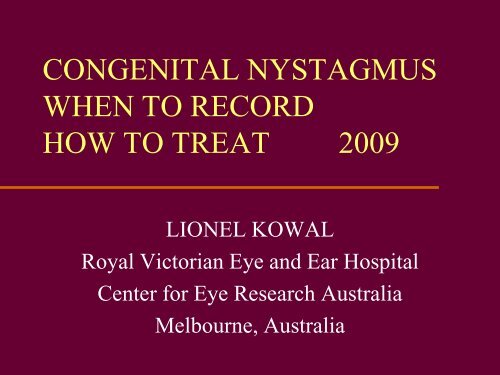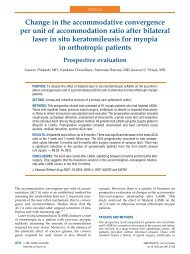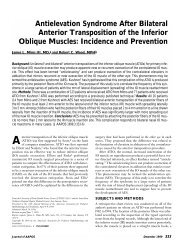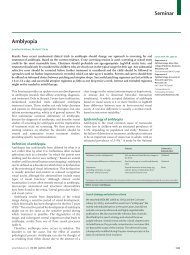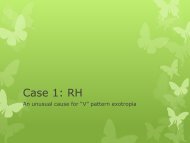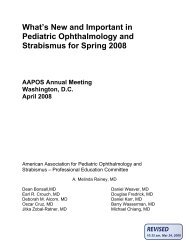Cong_Nystagmus 2009.pdf - The Private Eye Clinic
Cong_Nystagmus 2009.pdf - The Private Eye Clinic
Cong_Nystagmus 2009.pdf - The Private Eye Clinic
You also want an ePaper? Increase the reach of your titles
YUMPU automatically turns print PDFs into web optimized ePapers that Google loves.
CONGENITAL NYSTAGMUS<br />
WHEN TO RECORD<br />
HOW TO TREAT 2009<br />
LIONEL KOWAL<br />
Royal Victorian <strong>Eye</strong> and Ear Hospital<br />
Center for <strong>Eye</strong> Research Australia<br />
Melbourne, Australia
TYPES OF CONGENITAL<br />
NYSTAGMUS cN<br />
• cN: any type of early onset N<br />
• <strong>Cong</strong>enital N = CN<br />
aka <strong>Cong</strong>enital Motor N, <strong>Cong</strong>enital Sensory N, Idiopathic<br />
Infantile N IIN<br />
Common subtype: Periodic Alternating N PAN<br />
• LMLN<br />
Latent Manifest Latent <strong>Nystagmus</strong> aka<br />
FMNS = Fixation Maldevelopment N Syndrome.<br />
Can be MLN or ‘pure’ LN.<br />
Other: spasmusnutans, vestibular, …<br />
KOWAL MEACO 2009 2
<strong>Clinic</strong>al Features<br />
CN<br />
1. L beat on L gaze<br />
2. R beat on R gaze<br />
3. Eccentric null<br />
4. Convergence null<br />
5. Latent component<br />
6. Usu. Horizontal, can be<br />
torsional or vertical or all 3<br />
7. Oscillopsia uncommon<br />
8. Strabismus in some<br />
LMLN<br />
1. Fast beat to fixing eye<br />
2. Adduction null<br />
3. N on lateral gaze<br />
4. Latent component<br />
5. Usu horizontal, can be<br />
torsional or both<br />
6. Oscillopsia uncommon<br />
7. Strabismus in all<br />
…all well known<br />
KOWAL MEACO 2009<br />
3
Why does CN occur? 1<br />
• Poor symmetric acuity @ a critical<br />
time of visual development<br />
Sometimes there is continuing evidence of the initiating<br />
cause – eg bilateral optic n hypoplasia, symmetric terrible<br />
refraction, cone dystrophy, cataract OU, macular<br />
hypoplasia of albinism, …and sometimes there is no<br />
evidence of the initiating cause – macular hemorrhages,<br />
terrible refraction that got better, …<br />
KOWAL MEACO 2009<br />
4
Why does CN occur? 2<br />
• Genetic reasons – the N waveform itself<br />
can be inherited<br />
• Abnormal CNS : Peri Ventricular<br />
Leukomalacia PVL<br />
Many hypotheses / ?Multiple causes<br />
• ? abnormal circuit between fixation and ocular<br />
stabilisation systems<br />
• Abnormal proprioceptors in enthesis* [? cause, ?effect]<br />
* where tendon inserts into sclera<br />
KOWAL MEACO 2009<br />
5
Why does LMLN occur?<br />
• Asymmetry in motor or sensory<br />
development @ a critical time<br />
<strong>Cong</strong>enital strabismus, amblyopia,<br />
monocular cataract, PVL,<br />
unilateral optic n hypoplasia,…<br />
KOWAL MEACO 2009<br />
6
Whatever caused it, cNwill then<br />
degrade acuity further.<br />
In CN, the amount of further degradation is:<br />
1. reliably estimated by mathematically<br />
dissecting the waveform for NAFX factor<br />
[esp. in Cleveland?]<br />
2. estimated by assessing foveation time [the<br />
duration when N speed
Other effects of CN:<br />
• 2. Abnormal head posture<br />
e.g. sees 6/12 in 15° RG, 6/24 in 30º RG, 6/18 in PP, 6/30 in<br />
15º LG, 6/48 in 30º LG… will have FT to L ~ 15°<br />
• 3. Reduced visual field<br />
e.g. sees 6/12 in 15° RG, 6/24 in 30º RG, 6/18 in PP, 6/30 in<br />
15º LG, 6/48 in 30º LG… will have FT to L ~ 15°, and<br />
effectively restricted field of best acuity<br />
• 4. Strabismus<br />
KOWAL MEACO 2009<br />
8
Principles of treatment of CN<br />
•1. Improve the<br />
waveform<br />
•2. Improve 2ary effects<br />
such as face turn<br />
KOWAL MEACO 2009<br />
9
1. Improve the waveform<br />
• Drugs – gabapentin, memantine<br />
Fairly new. Often effective.<br />
Medium – long term results?<br />
• Contact lenses<br />
SCL & HCL have an effect > optical effect<br />
• BO Δ to induce convergence<br />
• Surgery<br />
• Are the effects of these sometimes<br />
additive?<br />
KOWAL MEACO 2009 10
2. Improve 2ary effects such as face turn<br />
•Prism glasses<br />
•Surgery<br />
KOWAL MEACO 2009<br />
11
Effects of treatment of CN<br />
• Improved waveform may result in<br />
improved acuity limited by any associated<br />
pathology<br />
• Expanded null zone = improved field<br />
of same or better acuity<br />
• Improved face turn – improved<br />
appearance and improved field<br />
KOWAL MEACO 2009<br />
12
Effects / Treatment of LMLN<br />
• Reduced acuity : make perfectly<br />
straight and convert MLN to LN<br />
• Face turn from adduction null: MR<br />
surgery<br />
• Head tilt from intorsion null: torsional<br />
surgery<br />
KOWAL MEACO 2009<br />
13
Defining the type of N<br />
•Do we need <strong>Eye</strong><br />
movement recordings<br />
EMR ?<br />
KOWAL MEACO 2009<br />
14
<strong>Clinic</strong>al Features<br />
CN<br />
1. L beat in L gaze / R beat in<br />
R gaze (either side of null<br />
zone)<br />
2. Eccentric null<br />
3. Convergence null (better<br />
reading VA)<br />
4. Latent component (can be<br />
pseudo-latent)<br />
5. Usu. horizontal, can be<br />
torsionalor vertical or all<br />
LMLN<br />
1. <strong>Nystagmus</strong> on lateral<br />
gaze (moving away<br />
from adduction null)<br />
2. Fast beat to fixing eye<br />
3. Adduction null – can<br />
cause face turn or head<br />
tilt<br />
4. Latent component<br />
5. Can be horizontal or<br />
torsional or both<br />
KOWAL MEACO 2009<br />
15
CN c.f. LMLN<br />
• CONVERGENCE<br />
NULL :<br />
• Both can have this –<br />
different mechanisms<br />
• Adduction null of<br />
LMLN can look like<br />
conv null of CN<br />
• ECCENTRIC NULL :<br />
• Both can have this –<br />
different mechanisms:<br />
• LMLN: null in<br />
aDuction or Intorsion;<br />
if RE dominant, will<br />
have FT to R or head<br />
tilt to R<br />
• CN: RE = LE<br />
KOWAL MEACO 2009<br />
16
CN c.f. LMLN<br />
• STRABISMUS :<br />
LMLN 100%<br />
CN ?30%<br />
• VERTICAL /<br />
TORSIONAL<br />
COMPONENT:<br />
• LMLN: T more than<br />
V<br />
• CN: V more than T<br />
KOWAL MEACO 2009<br />
17
CN c.f. LMLN : L beat on L gaze, R<br />
beat on R gaze [Alexander’s Law]<br />
• CN: N L on L of<br />
null zone, N R on<br />
R of null zone<br />
• LMLN :<br />
• LE is fixing & is in<br />
LG: BE have N L<br />
• LATENT<br />
COMPONENT:<br />
Both can have this – ?<br />
different mechanisms<br />
• RE is fixing & is in<br />
RG: BE have N R<br />
KOWAL MEACO 2009<br />
18
‘I AM WORSE THAN I USED TO BE’<br />
• LMLN:<br />
• Has lost binocularity<br />
and LN MLN<br />
• CN:<br />
• new neurological<br />
lesion has caused<br />
deterioration,<br />
or<br />
• Stress – common as a<br />
temporary mechanism,<br />
rarely permanent<br />
KOWAL MEACO 2009<br />
19
EMR features – usually<br />
diagnostic<br />
CN<br />
• Exponential increase<br />
in velocity in slow<br />
phase (unique)<br />
• Fast phase brings eye<br />
back to foveation<br />
LMLN<br />
• Decreasing velocity in<br />
slow phase (GPN)<br />
• Can be asymmetric in<br />
phase, amplitude or<br />
frequency<br />
20
<strong>Clinic</strong>al correlations : Dr Elaine Wong<br />
[Fellow]<br />
• Chart Review of cN pts n=84<br />
• 60 with EMR<br />
• 42 EMR & LK pre-EMR office<br />
diagnosis<br />
• 5 cases of PAN were excluded from analysis<br />
KOWAL MEACO 2009<br />
21
Overview: office c.f. lab diagnosis<br />
KOWAL MEACO 2009<br />
22
<strong>Clinic</strong>al and EMR Correlation<br />
KOWAL MEACO 2009<br />
23
Predictive Values of <strong>Clinic</strong>al<br />
Features – CN<br />
KOWAL MEACO 2009<br />
24
Predictive Values of <strong>Clinic</strong>al<br />
Features – CN<br />
KOWAL MEACO 2009<br />
25
Predictive Values of <strong>Clinic</strong>al<br />
Features – LMLN<br />
KOWAL MEACO 200926
Predictive Values of <strong>Clinic</strong>al<br />
Features – CN & LMLN<br />
KOWAL MEACO 2009<br />
27
Conclusions :<br />
<strong>Clinic</strong>al and EMR Correlation<br />
• Presence of convergence null – suggestive of CN<br />
• Eccentric null and nystagmus to direction of gaze<br />
– less predictive<br />
• No reliable clinical signs for LMLN<br />
Do EMR!!!<br />
No cardiologist would evaluate an arrhythmia without ECG<br />
No neurologist would evaluate epilepsy without EEG<br />
• Limitations exist! Can miss PAN!<br />
• Gold standard in diagnosing types of cN<br />
KOWAL MEACO 2009<br />
28
Does everyone with N need to be recorded?<br />
• Not if you’re absolutely certain about<br />
the diagnosis and have all the<br />
information you need for management<br />
OR<br />
• If you don’t need to know e.g.<br />
insignificant face turn, good acuity,….<br />
KOWAL MEACO 2009<br />
29
SURGERY IN cN : LMLN<br />
• Straighten eyes perfectly<br />
• ± 10 Δ not good enough: 0 Δ is<br />
needed<br />
• Will convert MLN to LN<br />
• Other surgeries for face turns and head tilts<br />
KOWAL MEACO 2009 30
SURGERY IN cN : CN<br />
• Eccentric null<br />
• Convergence null<br />
• Null in primary position<br />
• No definite null<br />
KOWAL MEACO 2009 31
SURGERY IN CN : Hertle’s operation<br />
• ANY surgery usually improves the<br />
waveform and may improve acuity even if<br />
main aim of surgery not accomplished eg<br />
residual face turn<br />
• Why not try the most basic component of<br />
surgery – ‘tenotomy – resuture’ - and see if<br />
that helps the waveform?<br />
• IT DOES<br />
KOWAL MEACO 2009 32
Eccentric null ≤ 20°<br />
L face turn<br />
Recess LMR 7mm & RLR 10 mm +<br />
tenotomy – resuture of the other<br />
two horizontal recti ~1 mm resection.<br />
If a small duction/version paresis is<br />
not created then the head posture<br />
will usually return.<br />
KOWAL MEACO 2009 33
Eccentric null ≥ 25°<br />
L face turn<br />
Recess LMR 7mm , RLR 10 mm<br />
recess<br />
Resect other 2 recti for total 17mm<br />
per eye.<br />
If a small duction/version paresis is<br />
not created then the head posture<br />
will usually return.<br />
KOWAL MEACO 2009 34
SURGERY IN CN : Convergence null<br />
• Prism adapt [no Fresnel] for max BOΔ<br />
• BMR x mm based on max BO Δ +<br />
tenotomy – resuture the lateral<br />
recti<br />
KOWAL MEACO 2009 35
SURGERY IN CN : No null or null in primary<br />
•Tenotomy – resuture<br />
the horizontal recti<br />
KOWAL MEACO 2009 36
SURGERY IN cN : PAN<br />
• Look for convergence null<br />
Prism adapt view BMR<br />
or<br />
• Tenotomy – resuture<br />
horizontal recti<br />
KOWAL MEACO 2009 37
SURGERY IN cN : warnings<br />
• Albinism patients: have<br />
positive angle kappa & look<br />
divergent when they are<br />
straight<br />
KOWAL MEACO 2009 38
THE RECENT PAST AND THE<br />
IMMINENT FUTURE<br />
• Increasing use of EMR to study the<br />
effects of different treatments and<br />
their combinations on our patients<br />
with cN will help us understand<br />
their condition better and plan<br />
more effective treatments<br />
KOWAL MEACO 2009 39
THANK YOU TO THOSE<br />
WHO TAUGHT & STILL<br />
TEACH ME ABOUT<br />
NYSTAGMUS: DRS.<br />
REINECKE, SPIELMAN,<br />
ABEL, DELLOSSO &<br />
HERTLE<br />
& THANK YOU TO THESE 2<br />
ACHIASMATIC BEAGLES WITH<br />
CN WHO CONTRIBUTED TO THE<br />
CLINICAL RECOMMENDATIONS<br />
IN THS TALK<br />
Lakota<br />
Copper<br />
KOWAL MEACO 2009<br />
40


